As an Amazon Associate, I earn from qualifying purchases with no additional costs for you.
It is easy to indulge with a fresh bottle of wine when you are sitting around with friends and good food, but what are you supposed to do with the wine that’s left? Most people assume that storing wine in the kitchen fridge is the best way to keep it fresh for more extended periods, but is that recommended?
Can you store wine in a kitchen fridge? Yes, but only in certain temperatures, and only for a limited amount of time. Ideally, wine should be stored between 45 and 65 degrees Fahrenheit, but because most fridges are not set to maintain temperatures above 40 degrees, this method of storage is not recommended for long-term use.
This article will cover all the proper ways that you can store your wine, including refrigeration, and what happens to wine when it is stored improperly.
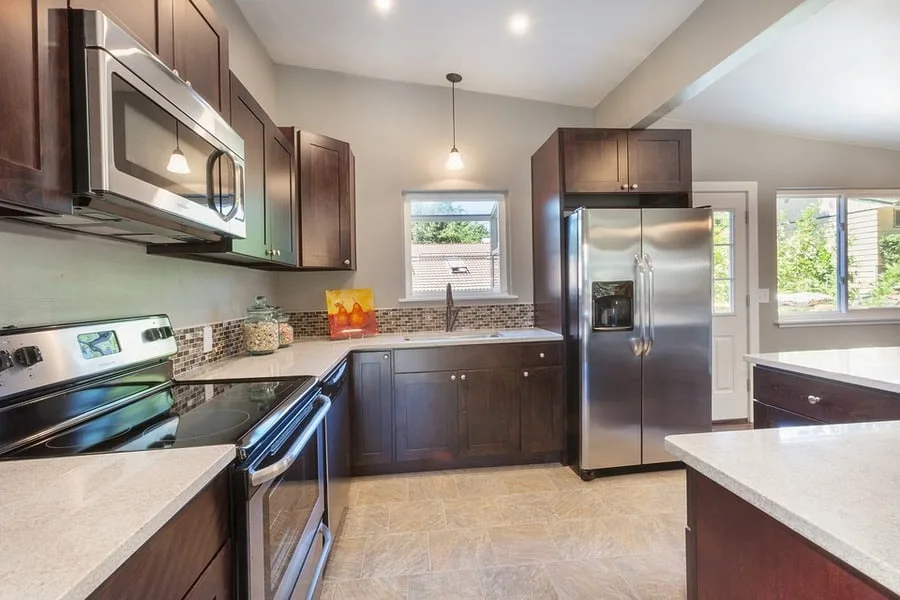
TIP: If you want to check out the best refrigerator for wine storage, I recommend trying out the Avation (18 bottles) compressor refrigerator with Wi-fi smart app control cooling system. You can find this refrigerator by clicking here (Amazon link).
Can You Store Wine in a Kitchen Refrigerator?
As mentioned before, wine can certainly be stored in a kitchen fridge. However, it is not recommended for long-term storage. This is because of the wine’s temperature requirements to maintain freshness and maturity.
Wine is best stored in temperatures between 45 and 65 degrees Fahrenheit. However, most, if not all, kitchen refrigerators are not able to stay above 40 degrees—and even if they could go above this threshold, your food items would certainly pay the price.
In other words, the highest temperature you would be able to keep in your fridge for proper wine storage is 40 degrees; since this is a slight temperature difference, keeping a few bottles of wine inside for a couple of weeks will not cause significant harm.
However, long-term storage at 40 degrees and lower will eventually stunt the maturity of the wine. Essentially, wine does not sit well with temperature fluctuations and moving it between room temperature, and a very cold refrigerator will throw it off. It is always better to keep it stored at one consistent temperature, at least until it is opened.
TIP: If you want to learn how cold a wine refrigerator can get and why it is important for wine storage, check out this article. To learn the proven 8 steps for long-term wine storage, this article is a great read.
How to Store Wine in Kitchen Refrigerators
Although wine, in general, can be stored in the fridge, how it is stored, and how long it should be stored will depend on its type.
Recommendation box: Everything you need to enjoy your wine as much as possible. All recommended products are personally tested and regularly used by experts from this website (Amazon links):
> Ivation Wine Cooler – Energy-efficient wine cooler for 18 bottles with Wi-fi smart app control cooling system.
> Wine Rack – Beautiful, elegant wood rack for up to 7 bottles and the choice of vertical or horizontal storage.
> Durand Wine Opener – Classic vintage wine opener (we like all these classic staff).
> YouYah Iceberg Wine Decanter – The most beautiful and handy wine decanter we personally use.
> Bormioli Rocco Wine Glasses – A set of eight elegant and traditional wine glasses made in Italy.
> Vintorio Wine Aerator – Simple but really useful wine aerator for a reasonable price.
> The Original Vacu Vin Wine Saver – The best wine saver on the market in a package with two vacuum stoppers and two wine servers.
And if you want to become a true connoisseur of wine, we recommend reading the book Wine Folly: The Essential Guide to Wine (Amazon link), where you will find all the information you need about winemaking, wine varieties, flavors, and much more.
Storing White Wine in the Kitchen Fridge
White wine can be stored at colder temperatures for longer, but below 40º is a little too cold for the wine and may cause some fallout of flavor. If you are going to store white wine in the kitchen fridge, don’t let it sit for longer than a couple of weeks.
As you may know, humidity is important to keep during wine storage; however, as a fridge maintains its cold temperatures, it removes any presence of humidity. That is why uncovered herbs and vegetables inside eventually lose their structure; there is simply no moisture in the air.
Because white wines have fewer phenolic compounds than red wine and are more prone to spoiling inside the bottle, wine producers use screw top caps for white wine rather than corks. Screw top caps create a more secure seal, and they are cheaper and more environmentally friendly to use than cork.
You can also reuse the lid to seal the bottle until it is empty. Another advantage to screw caps for storage: the bottle can be stored standing upright rather than lying horizontally.
Wines sealed with a cork, that are going to be stored for an extended period of time, must be placed in a horizontal position to keep the cork moist so that it maintains a tight seal against the bottle’s neck.
TIP: Are you interested in buying a wine stopper? We’ve personally tried and recommend buying one of these wine stoppers (Amazon links):
- The Original Vacu Vin Wine Saver: Our top choice. Very easy-to-use wine stopper/saver. You can enjoy a glass of fresh wine whenever you want without worrying about wasting any.
- EZBASICS Wine Saver: Great alternative to Original Vacu Vin Saver. This wine stopper keeps the flavor of wine for up to one week.
- Champagne Stopper by MiTBA: Wine stoppers for sparkling wines are different. This wine stopper seals your bottle and increases the pressure so your beverage’s bubbles won’t go to waste.
Storing Red Wine in the Kitchen Fridge
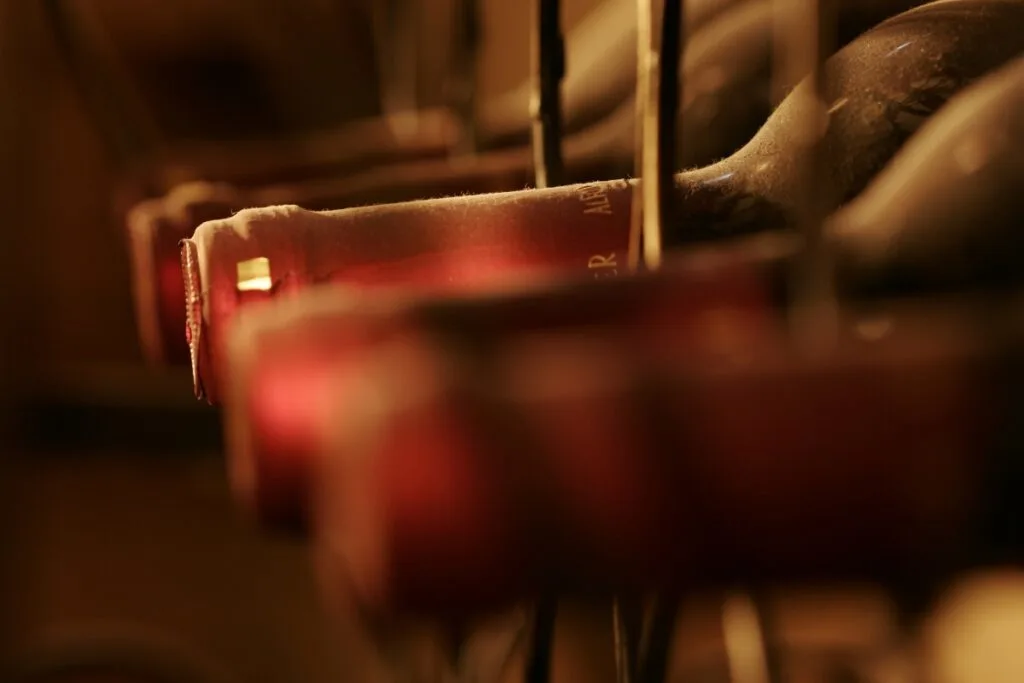
It is not recommended to store red wine in the kitchen fridge. The wine will get too cold to drink right away and need some time warming up, and that change in temperature may have adverse effects on the wine; it is essentially a shock to the ecosystem in the bottle.
With that said, there is also nothing wrong with having a chilled glass of red wine from the fridge. There are many varieties of red wine, like Lambrusco, that beg to be served chilled—not as cold as white wine, but colder than a full-bodied red like a Cabernet or a Syrah.
TIP: A suitable wine glass is the basis for enjoying well-being while drinking your favorite wine variety. Here are our favorite ones (Amazon link):
- Bormioli Rocco Crystal Wine Glasses: A set of eight elegant and traditional wine glasses made in Italy for a reasonable price.
- Riedel VINUM Wine Glasses: Luxury set of two wine glasses suitable for any occasion. We just love them!
- Schott Zwiesel Tritan Crystal Glasses: If you like unusual alternatives, a set of six stemless glasses made of crystal glass.
Just be sure that you don’t leave the bottle in the refrigerator for too long—just long enough to give it the slight chill you need for serving.
General Storing Tips for Kitchen Fridges
Because it is easier to lose track of a bottle in the fridge, make sure that you date the back of the container on the day it was opened.
This is an old restaurant trick to keep track of wine, and it is such a popular method, some wine producers reserve an area on the bottle’s label for this purpose.
Kitchen Fridge vs. Room Temp Storage
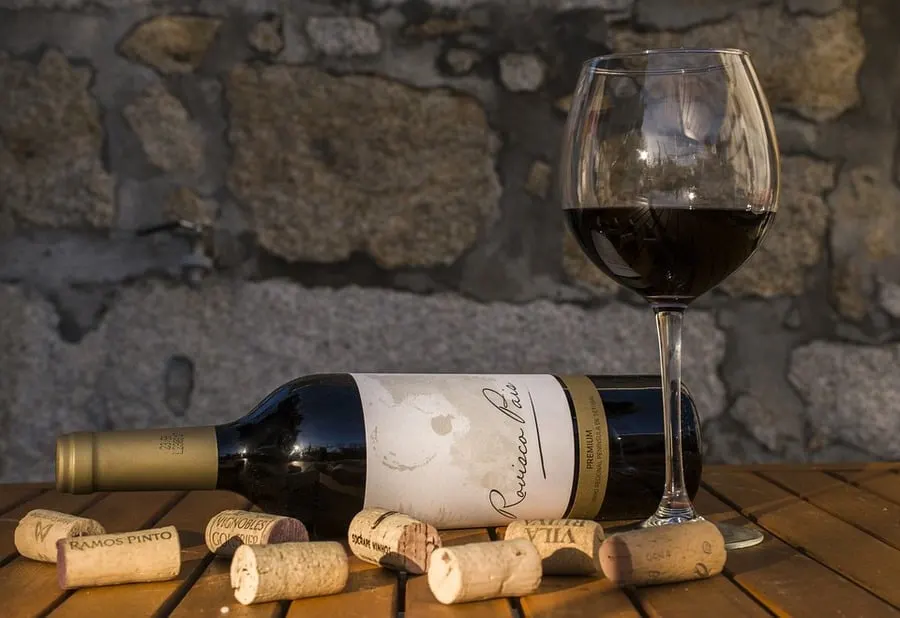
Deciding whether to store your wine in the kitchen fridge or at room temperature is entirely subjective, but it also depends on the type and quality of the wine.
- The kitchen fridge is a fine place to store white and sparkling wine for a short amount of time, especially if the bottle has been opened. But, if you don’t know when you are going to open the bottle, room temp is recommended for extended storage periods.
Red wine should not be stored in the kitchen refrigerator unless it has been opened. There are many phenolic compounds in red wine, and saving at a temperature below 40 degrees will cause the compounds to fall out, causing the wine to taste bland and flavorless.
Wine Refrigerator vs. Kitchen Fridge
An alternative for using a traditional kitchen refrigerator is a specialized wine fridge. Unlike kitchen fridges, wine fridges are going to provide you with complete control for wine storage conditions, but whether or not it is a better option depends on the type of wine you plan on storing and how soon you want to drink it.
For example, if you usually end up drinking a bottle of wine a week, chances are there is no need to invest in a wine refrigerator. However, if you collect vintage wine and have more than you would like to drink within a month, a wine fridge will undoubtedly come in handy.
Many wine fridges have two separate compartments, each with its thermostat and climate controls for humidity and temperature. (The reason there are usually two sections is that white and sparkling wine need to be kept colder than red wine. We’ll go into more detail about their storage differences later.)
Best Wine Refrigerator for Wine Storage
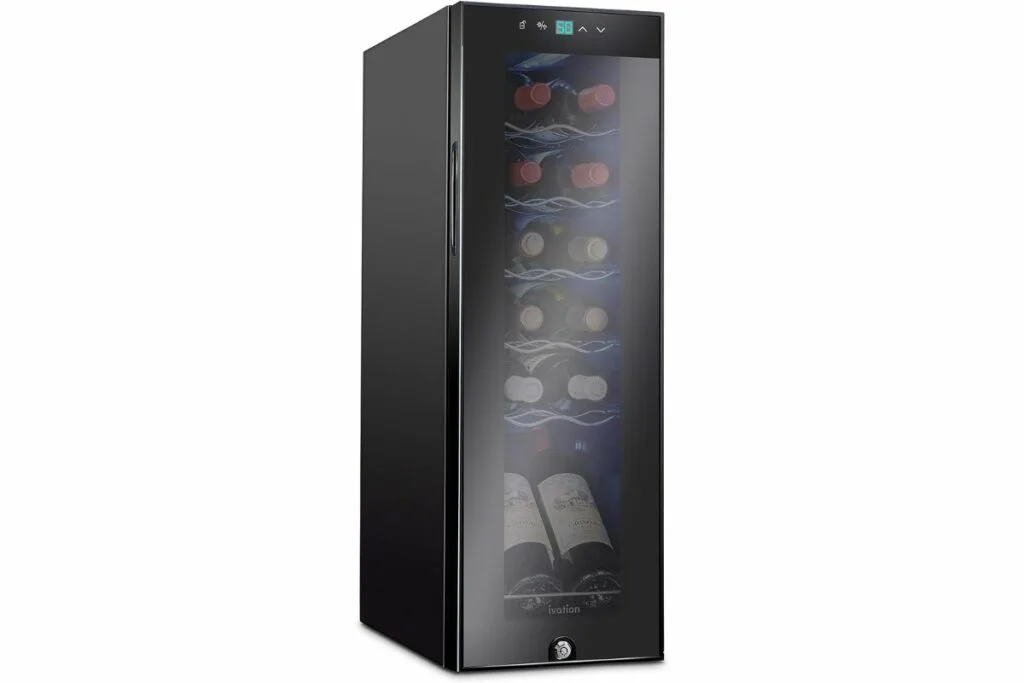
There are countless incredible wine refrigerators available so I can’t just label one as the best without testing them all which is impossible on my current budget. Instead, I want to recommend one that I love. The NutriChef PKCWC120 12-Bottle Wine Refrigerator is a fantastic “small” capacity wine fridge that is ideal for both small apartments and large spaces alike (read the reviews on Amazon).
It used compressor cooling technology which will more efficiently keep wine at a steady cool temperature. The customer reviews this fridge was earned are astounding.
If you are reading this article hoping to store wine in a kitchen fridge, I recommend this wine refrigerator. It is very inexpensive to buy and will keep your wine much better than any kitchen fridge could.
Best Way to Store Wine
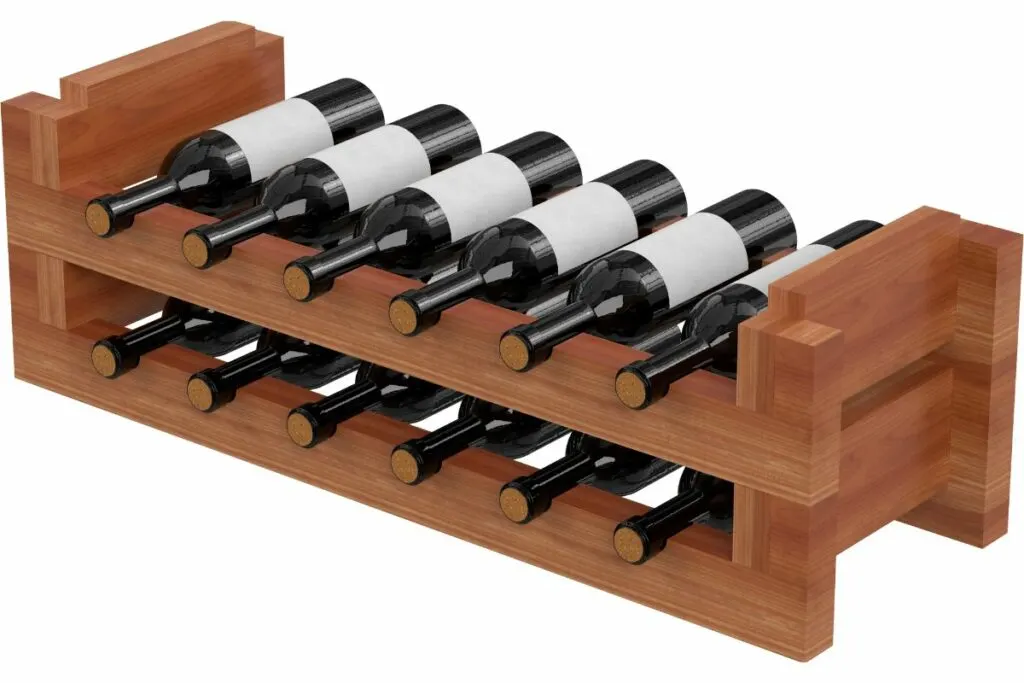
So, if the kitchen fridge isn’t the ideal way to store wine, what is? The best place to store wine is a room that meets the following criteria:
- Temperature – As previously mentioned, wine is best stored in a temperature-controlled environment kept between 45 and 65 degrees Fahrenheit. A room that is too hot will “cook” the wine, leading to a raisin-like and musky flavor. A room that is too cold will make wine flat and without the body.
- Light – Keep wine stored in a dark room. Direct sunlight or incandescent light will affect the phenolic compounds of the wine, creating wine faults. (Phenols are naturally occurring chemicals produced by plants that create the complex aromas found in wine. One of the most common phenols you might recognize in wine are tannins, the bitter, drying taste that is derived from the skins, stems, and seeds of the grape.)
- Humidity – Wine also requires a certain humidity (about 65 to 75 percent). This keeps the cork supple, preventing air and bacteria from getting into the wine. If the cork dries out, then several things can go wrong for the wine: most often, the wine becomes oxidized, which makes it smell and taste like vinegar. Many wine cellars allow controlled humidity.
How you store wine in this type of environment is also essential: Lay the bottle on its side, turning it every three weeks; the reason wine is stored on its side is to ensure the cork is consistently touching liquid inside the bottle. This helps prevent the cork from drying out.
TIP: Having quality storage racks for your wine is not only practical but can also serve as a nice design accessory for your home. We loved these (Amazon links):
- Ferfil Wine Rack (10 Bottles): Concertina/scissor fold wooden wine rack made of solid, eco-friendly wood.
- Gusto Nostro Wood Wine Rack: Beautiful, elegant design, the possibility of storing up to 7 bottles, and the choice of vertical or horizontal storage.
Open vs. Closed Bottle Storage
So much of the process of creating wine is controlling how much air touches the drink. There are two types of fermentation that grapes undergo to become wine:
- Aerobic fermentation uses oxygen to feed yeasts that turn the natural sugars in the juice into carbon dioxide. This initial fermentation can take up to 5 to 10 days.
- The second fermentation happens when the juice is resting in a barrel. This is called anaerobic fermentation, which is the process of yeasts breaking down glucose without the presence of oxygen. This process takes up to three weeks.
After the second fermentation, exposure to oxygen is detrimental to the wine’s maturity.
However, a little bit of air is a good thing for wine. Ethanol – alcohol – is less dense than the juice in the bottle, and it sits right on top of the wine. If you look closely enough, you will see a translucent layer of liquid on top of wine: that is straight alcohol.
Once a bottle of wine is opened, the ethanol vapors are released, which can have an overpowering aroma. That is why you hear people say, “the wine needs to breathe.” This means that the wine needs to oxidize for a moment and let the initial vapors settle.
With that said, always store wine with a cork or cap. Too much air will jump-start aerobic fermentation in the wine, causing spoilage. Reinsert the cork or use a bottle stopper to store the wine. This is why storing open or closed bottles of wine in the kitchen fridge can be problematic.
TIP: To learn how to store opened white wine to make it last just a little longer, read this helpful guide. This article discusses 8 effective ways of storing wine without the cork that will work!
Wine Pumps for Better Open-Wine Storage Inside Refrigerator
For the most secure storage of an open bottle, invest in a wine pump like this awesome one. This method extracts the air left in the bottle and preserves the wine for longer; this is how restaurants keep their wines fresh.
A wine pump comes with a rubber stopper that you put into the bottle and then you lightly place the pump over the cap and start pumping.
This action sucks the air out of the bottle, and when it is all finished, you will hear a little click, or you can tell because it will be difficult to continue pumping.
When you are ready to drink again, press the center nubbin to the side, and you will hear a whoosh of air, then a slight pop when you take the rubber cork out.
Other Alternatives to Corking
The following are a few tricks if you end up misplacing the cork. These tricks are not going to preserve the wine for more than a day in the kitchen fridge, but it will work if you’re in a pinch.
- Put the handle of a spoon in the bottle. It sounds crazy, but it works. Don’t let the handle touch the wine, so you might have to drink or use a little more wine. The science behind the myth is that the spoon acts like an air trap, keeping warm air and the top near the bowl of the spoon and keeping cooler air in the bottle.
- Storing opened wine in a kitchen fridge is doable because your fridge is so cold, it slows down the process of oxidation. If you do have some wine leftover and no bottle stopper, make sure that it is in the refrigerator. You might be able to save some wine for tomorrow.
But, if the wine has already turned before or after these methods, do not throw it out; instead, to make sure it doesn’t go to waste, you can always use it for cooking.
Storing Reds & Whites: Refrigeration
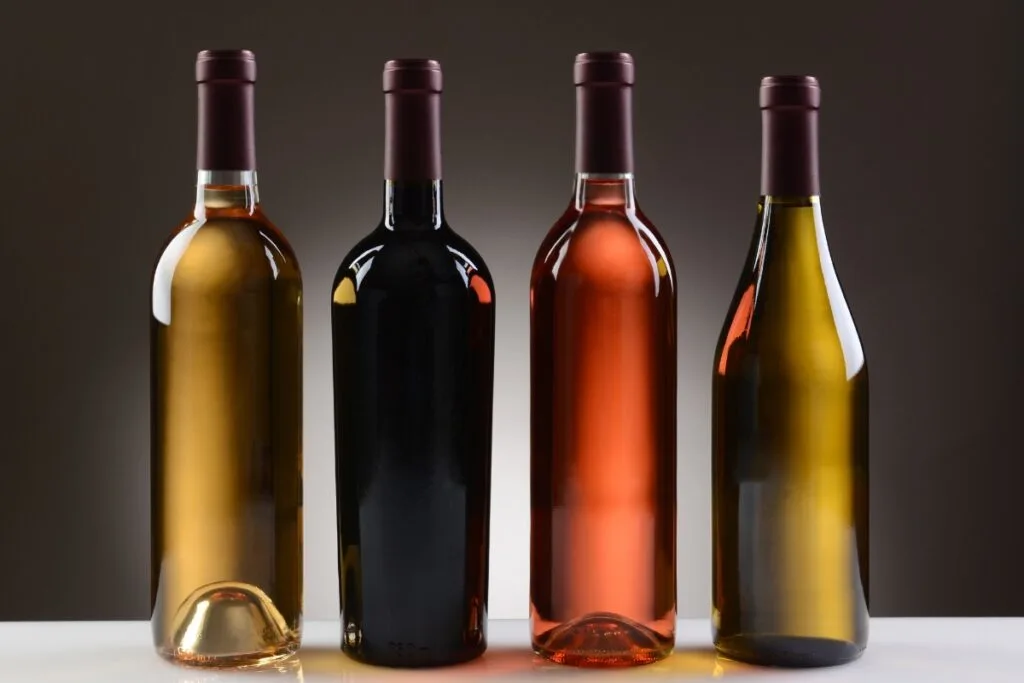
Looking at wine in general, there are four categories; each category can be broken down by country, region, varietal, producer, vineyard, and then style.
Each type of wine has its distinctive properties, which require different storing and serving methods. The following explains how storage will differ among these several common types of wine:
White Wine
Stored colder than 40 degrees for an extended period—like in a kitchen fridge—will make white wine taste flat and bland.
It will have a little more body as the temperature rises, and the wine comes in contact with air, but it will not have the same flavor profile as if it were to be stored properly. No harm can be done storing white wine at room temperature, as long as it doesn’t get above 70 degrees.
However, white wine is more vulnerable to light and temperature than red wine and should be stored slightly colder, between 45 to 50 degrees, when possible, especially for long-term storage. It is best served cold, right out of the fridge.
You can also tell if your white wine is no longer fresh from the color. Light-bodied white wines like sauvignon blanc or pinot grigio should be very clear with a very pale, light yellow color.
Chardonnay or other white wines that have been treated with oak may be slightly darker in color than other white varietals.
However, any browning or even a deep golden color is an indication the wine has oxidized.
Red Wine
Red wine should be stored and served at a warmer temperature, between 50 and 60 degrees. It is fine to leave red wine out at room temperature as long as it is kept away from direct sunlight and does not experience temperature fluctuations.
Blush or Rosé
Blush or rosé wines should be treated similar to white wines, serving between 45 to 50 degrees, and storing between 40 and 60 degrees.
Sparkling
Sparkling wine should be stored similar to white wine because it is an extremely vulnerable wine. Keep it away from harsh light and temperature fluctuations, and store and serve chilled between 40 to 50 degrees Fahrenheit.
Sparkling wine is overly sensitive to temperature fluctuations and can cause severe damage, not only to the wine but to innocent bystanders as well. A secondary bottle fermentation produces carbonation in sparkling wine.
This process creates an immense amount of pressure in the bottle; if the wine gets too hot, the pressure will force the cork to shoot off. This is why there are often wire casings holding the cork onto a bottle of sparkling wine.
On the other hand, if the wine freezes, the liquid will expand and can shoot the cork right out of the bottle as well. To avoid this entirely, keep sparkling wine between 40-50 degrees Fahrenheit, as mentioned above.
TIP: What are the dos and don’t of proper wine storage? Find out here. If you don’t have a wine refrigerator, how do you store wine properly? Read this article to find out.
Conclusion
While it is possible to store wine in the kitchen fridge, it is only recommended to do so for a short period, and usually works best for keeping white, blush or rosé, or sparkling wine.
Never store red wine in the fridge if you can help it. A kitchen refrigerator is simply too cold for wine and will affect its overall taste over time.
If you want to keep red wine cool, it is better to invest in a wine fridge that is designed to maintain ideal temperatures for storing it. Most wine fridges have two compartments, so you can isolate white and red wines in their ideal environment.
However, the ideal way to store wine is in a temperature and humidity-controlled environment that is dark. Wine cellars often meet these criteria.
However, if you do not have a wine cellar, as long as you follow the above storage guidelines you can easily continue collecting your favorite bottles.
In conclusion, there is a reason why wine has been carried from generation to generation gaining popularity and the passions of people all over the world.
No matter if you bought a $5 bottle in a grocery store to have with dinner, or if it is the prized possession in a million-dollar collection, wine is meant to be shared. Maintaining proper storage and care for any bottle of wine will provide for a perfect drinking experience.
TIP: Check out this page for a complete list of wine products and accessories I love. You’ll find my recommendations for wine refrigerators, decanters, and aerators and the best place to buy wine online. Click here to see the complete listing.
